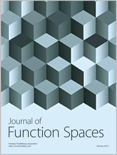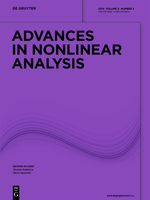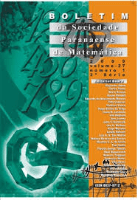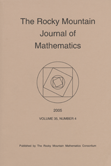
Journal of Function Spaces
Scope & Guideline
Exploring the Depths of Mathematical Analysis
Introduction
Aims and Scopes
- Function Spaces and Their Properties:
The journal emphasizes the study of various types of function spaces, including Sobolev spaces, Hardy spaces, and Besov spaces, examining their mathematical properties and applications. - Fixed Point Theory:
A significant focus is placed on fixed point theorems, including both classical and modern approaches, and their applications in various fields such as differential equations and optimization. - Fractional Calculus:
Research related to fractional calculus, including fractional differential equations and inequalities, is a core area of interest, with articles exploring both theoretical and computational aspects. - Inequalities and Their Applications:
The journal publishes studies on inequalities related to functions, including Hermite-Hadamard and Jensen-type inequalities, and their implications across different mathematical fields. - Mathematical Modeling:
There is a strong emphasis on mathematical modeling in various contexts, including applications in physics, engineering, and finance, showcasing the practical relevance of theoretical findings. - Graph Theory and Applications:
The journal also explores topics in graph theory, particularly those that intersect with function spaces and fixed point theory, highlighting their relevance in combinatorial mathematics.
Trending and Emerging
- Fractional Differential Equations:
There is a notable increase in publications concerning fractional differential equations, reflecting a growing interest in this area and its applications in modeling real-world phenomena. - Advanced Fixed Point Theorems:
Recent years have seen an upsurge in studies on advanced fixed point theorems, including new types of contractions and their applications across various mathematical disciplines. - Computational Methods in Function Spaces:
The journal is increasingly publishing articles that focus on computational techniques for solving problems in function spaces, indicating a trend towards practical applications of theoretical results. - Interdisciplinary Applications:
Research that applies function space theory to interdisciplinary fields, such as biology, finance, and engineering, is on the rise, demonstrating the broadening impact of function spaces. - Inequalities and Optimization Problems:
The exploration of inequalities within the context of optimization problems has gained momentum, with more studies investigating their theoretical foundations and practical implications.
Declining or Waning
- Application of Fuzzy Set Theory:
While previously a significant focus, the application of fuzzy set theory in function spaces and related areas has seen a reduction in publications, indicating a possible shift towards more traditional mathematical approaches. - Neutrosophic Set Theory:
The interest in neutrosophic set theory, though innovative, appears to be waning, as fewer articles are being published that explore its applications in function spaces. - Statistical Applications in Function Spaces:
The integration of statistical methods within the framework of function spaces has become less prominent, possibly due to a shift towards more deterministic mathematical approaches. - Emerging Techniques in Numerical Analysis:
The focus on novel numerical techniques specific to function spaces has declined, suggesting that researchers may be gravitating towards more established methods.
Similar Journals

Advances in Nonlinear Analysis
Bridging Theory and Application in Nonlinear AnalysisAdvances in Nonlinear Analysis is a highly regarded academic journal dedicated to the exploration and dissemination of research in the field of nonlinear analysis. Published by DE GRUYTER POLAND SP Z O O, this journal has established itself as a pivotal resource for scholars and practitioners, achieving an impressive Q1 ranking in the Mathematics - Analysis category, and placing in the top 97th percentile within its discipline as per the latest Scopus rankings. With an Open Access model since 2018, Advances in Nonlinear Analysis ensures that cutting-edge research is readily accessible to a global audience, promoting the advancement of knowledge without barriers. Covering a broad spectrum of topics within nonlinear analysis, this journal invites contributions that involve either theoretical or applied aspects, making it an essential platform for exchanging innovative ideas and results in this dynamic field. Researchers, professionals, and students alike will find this journal invaluable for staying abreast of the latest developments and methodologies in nonlinear analysis.

Bulletin of Mathematical Analysis and Applications
Pioneering Theoretical and Practical Insights in MathematicsBulletin of Mathematical Analysis and Applications is a distinguished academic journal published by UNIV PRISTINA, DEPT MATHEMATICS COMPUTER SCIENCES, located in the vibrant city of Prishtina, Kosovo. This journal is dedicated to the dissemination of groundbreaking research in the fields of Mathematical Analysis and Applied Mathematics, focusing on both theoretical and practical aspects of these disciplines. While currently categorized in the Q4 quartile for analysis, applied mathematics, and miscellaneous mathematics, the journal is on an upward trajectory, welcoming contributions from researchers and professionals who strive to advance the frontiers of mathematical knowledge. Though its Open Access status is still to be developed, the journal remains committed to fostering a scholarly environment that promotes collaboration and innovation. With convergence years set from 2019 to 2024, the Bulletin of Mathematical Analysis and Applications aims to be an essential resource for those pursuing advancements in mathematics, providing a platform for new ideas and methodologies to flourish.

Matematicki Vesnik
Connecting scholars through open-access mathematics.Matematicki Vesnik is a distinguished open-access journal published by the MATH SOC SERBIA-DRUSTVO MATEMATICARA SRBIJE, dedicated to advancing the field of mathematics since its inception. With an ISSN of 0025-5165 and an E-ISSN of 2406-0682, this journal has been a significant platform for disseminating research findings since its establishment in 1993. Hosted in Serbia, it embraces a broad scope of mathematical discourse while achieving a Q3 category ranking in miscellaneous mathematics for 2023. As part of its commitment to fostering scholarly communication, Matematicki Vesnik is accessible to a global audience, promoting high-quality research and innovative ideas within the mathematical community. With converged years from 1999 to 2024 and a Scopus rank of #232 out of 399 in General Mathematics, the journal plays a crucial role in enhancing visibility and impact for researchers, professionals, and students alike in the dynamic landscape of mathematical inquiry.

Boletim Sociedade Paranaense de Matematica
Championing Open Access in Mathematical ResearchBoletim Sociedade Paranaense de Matematica is a distinguished journal within the field of Mathematics, published by the Sociedade Paranaense de Matemática in Brazil. With an ISSN of 0037-8712 and an E-ISSN of 2175-1188, this journal has been committed to fostering open access to mathematical research since 2002, ensuring that cutting-edge research is readily available to the academic community. Operating within the diverse landscape of mathematical studies and ranked Q3 for 2023 in the category of Mathematics (Miscellaneous), the journal serves as a platform for innovative contributions and discussions. It ranks 192nd out of 399 in the Scopus database for General Mathematics, reflecting its steady involvement in the global academic dialogue. The Boletim resides at JD AMERICAS, CAIXA POSTAL 19081, CURITIBA PR 81531-990, Brazil, and aims to connect researchers, practitioners, and students by promoting high-quality research and dissemination of mathematical knowledge. By bridging diverse mathematical theories and applications, the journal not only enhances understanding of the discipline but also drives future research directions.

Eurasian Mathematical Journal
Exploring Mathematical Frontiers, Empowering Minds.Welcome to the Eurasian Mathematical Journal, a prominent platform dedicated to advancing the field of mathematics, particularly in its miscellaneous applications. Published by the esteemed L N Gumilyov Eurasian National University in Kazakhstan, this journal has been serving the academic community since 2014. With an ISSN of 2077-9879, it has successfully carved its niche within the mathematical landscape, presently ranked Q2 and placing in the 64th percentile among general mathematics publications in Scopus. The journal aims to foster scholarly exchange through high-quality research articles, reviews, and theoretical advancements that enhance understanding and application of mathematical concepts. By prioritizing open accessibility and a rigorous peer-review process, the Eurasian Mathematical Journal contributes significantly to both theoretical exploration and practical innovation, making it an essential resource for researchers, professionals, and students alike.

Applied Mathematics E-Notes
Unlocking the Potential of Applied Mathematics for AllApplied Mathematics E-Notes, a prominent publication within the field of Applied Mathematics, is produced by the Department of Mathematics at Tsing Hua University in Taiwan. With its inception in 2001, the journal continues to serve as a vital resource for disseminating research findings, methodologies, and applications that advance the understanding of mathematical theories and their practical implications. Though currently categorized in Q4 within its field, the journal remains dedicated to fostering innovation and collaborative research, reflecting its growth potential in the coming years. The journal is accessible online, catering to a global audience of researchers, professionals, and students seeking to enrich their knowledge and engage with contemporary topics in applied mathematics. Through its commitment to open dialogue in mathematical sciences, Applied Mathematics E-Notes plays an essential role in bridging theoretical research with real-world applications.

Fixed Point Theory
Unlocking the Potential of Fixed Point ApplicationsFixed Point Theory, published by HOUSE BOOK SCIENCE-CASA CARTII STIINTA, is a distinguished journal that has garnered attention in the fields of mathematical analysis, applied mathematics, and computational mathematics. With an ISSN of 1583-5022 and an E-ISSN of 2066-9208, this journal serves as a vital platform for disseminating innovative research and significant developments in fixed point theory and its numerous applications. Its emergence as a Q3-ranked journal in 2023 across multiple categories indicates its growing influence within the academic community, particularly in Romania and beyond. Researchers, professionals, and students alike will find Fixed Point Theory an essential resource for staying abreast of the latest findings, methodologies, and theoretical advancements in these critical areas of mathematics, fostering a deeper understanding and stimulating further exploration in both foundational and applied settings.

RICERCHE DI MATEMATICA
Fostering Connections Through Cutting-Edge ResearchRICERCHE DI MATEMATICA, published by SPRINGER-VERLAG ITALIA SRL, is a prominent academic journal situated at the intersection of mathematics and its applications, with an ISSN of 0035-5038 and an E-ISSN of 1827-3491. Based in Italy, this journal serves as a crucial platform for disseminating innovative research findings and theoretical advancements in the diverse fields of applied mathematics and general mathematics, currently ranked in the Q3 quartile as per the 2023 category evaluations. The journal's standing is underlined by its impressive Scopus rankings, securing the 61st position out of 399 in General Mathematics and the 224th in Applied Mathematics, placing it well within the 84th and 64th percentiles respectively. Catering to a global audience of researchers, professionals, and students, RICERCHE DI MATEMATICA not only celebrates mathematical exploration but also enhances understanding through open discourse by fostering connections among scholars from various mathematical disciplines. With a converged publication cycle spanning from 2007 to 2024, the journal is committed to promoting high-quality research that shapes the future of mathematical sciences.

ROCKY MOUNTAIN JOURNAL OF MATHEMATICS
Fostering Collaboration in Diverse Mathematical FieldsROCKY MOUNTAIN JOURNAL OF MATHEMATICS, published by the Rocky Mountain Math Consortium, serves as a critical platform for researchers and practitioners in the field of mathematics since its inception in 1971. With a notable presence in the academic community, this journal covers a broad spectrum of mathematical disciplines, positioning itself in the Q2 category for Mathematics (miscellaneous) as of 2023. Despite being a subscription-based journal, it is recognized for its rigorous peer-review process and contributions to theoretical and applied mathematics, helping to advance knowledge and foster collaboration among mathematicians. The journal's ISSN number is 0035-7596 and its E-ISSN is 1945-3795, reflecting its commitment to accessibility and dissemination of high-quality research. Based in Tempe, Arizona, at Arizona State University, the journal continues to play an important role in shaping contemporary mathematical discourse through well-researched articles and innovative studies, aiming to bridge gaps between various mathematical subfields and engage a diverse audience, including students and established researchers alike.

ACTA SCIENTIARUM MATHEMATICARUM
Fostering Connections Between Theory and PracticeACTA SCIENTIARUM MATHEMATICARUM, published by SPRINGER BIRKHAUSER in Switzerland, is a distinguished journal focusing on the fields of mathematical analysis and applied mathematics. With an ISSN of 0001-6969 and an E-ISSN of 2064-8316, this journal serves as a critical platform for disseminating high-quality research that bridges theoretical and practical aspects of mathematics. Although currently categorized in the Q3 quartile for both Analysis and Applied Mathematics as of 2023, the journal strives to enhance its impact on the mathematical community by offering a perfect blend of rigorous research and innovative applications. Researchers, professionals, and students can benefit from the journal’s commitment to advancing knowledge in mathematics, despite the absence of open-access options. The mailing address for correspondences is 233 SPRING STREET, 6TH FLOOR, NEW YORK, NY 10013. As mathematics continues to evolve, ACTA SCIENTIARUM MATHEMATICARUM positions itself as a valuable resource for those looking to contribute to and stay informed about the latest developments in this vibrant field.